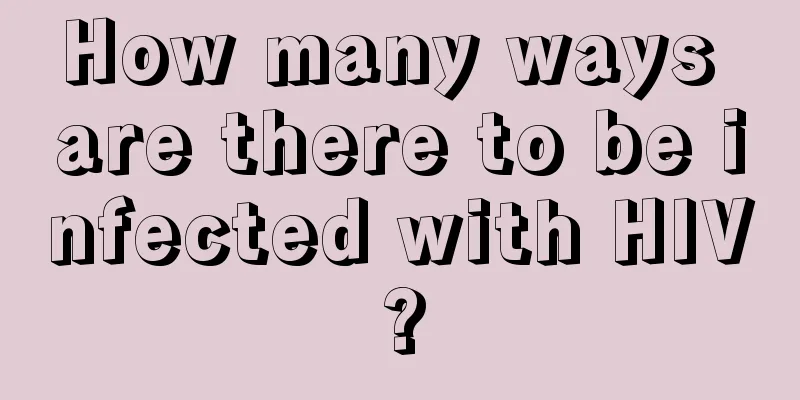How many ways are there to be infected with HIV?

|
There are more and more AIDS patients. Many people are afraid when they hear the word AIDS. Many people dare not come into contact with AIDS patients because they are afraid that they will get AIDS after contacting them. This is because they do not understand how AIDS is transmitted. In fact, the main ways of transmission of AIDS are sexual contact, blood transmission and mother-to-child transmission. How are they transmitted? 1. Transmission routes of AIDS AIDS is a common sexually transmitted disease that is extremely harmful to human health. There is currently no complete cure. The main ways of AIDS infection are sexual contact, blood transmission, and mother-to-child transmission. Blood transmission includes the transfusion of contaminated blood products, or sharing of needles, major medical accidents, etc., all of which can easily lead to infection with the HIV virus. (1) Sexual contact transmission: Includes sexual contact between the same and opposite sexes. (2) Blood transmission: include: ① Transfusion of HIV-contaminated blood or blood products; ② Intravenous drug addicts share HIV-contaminated, unsterilized needles and syringes; ③ Sharing other medical equipment or daily necessities (such as sharing toothbrushes or razors with infected people) may also cause infection through damaged areas, but this is rare. ④ Incomplete or no disinfection of syringes and needles: Especially for children, preventive injections that are not given one needle and one tube per child are more dangerous; oral instruments, delivery instruments, surgical instruments, and needles for acupuncture treatment are not strictly disinfected or are not disinfected; needles and shaving tools for haircuts, beauty treatments (such as eyebrow tattoos, ear piercings), tattoos, and pedicure knives in the bathroom are not disinfected; sharing razors, razors, or toothbrushes with others; transfusions of blood or blood products from donors who have not been tested for HIV antibodies, as well as bone marrow transfusions and organ transplants in similar situations; when rescuing a bleeding casualty, the rescuer's own broken skin comes into contact with the casualty's blood. (3) Mother-to-child transmission: Also known as perinatal transmission, it means that an HIV-infected mother transmits HIV to the fetus or baby before, during, and shortly after birth. It can be transmitted through the placenta, through the birth canal during delivery, or through breastfeeding. After knowing these transmission routes of AIDS, you can take preventive measures and no longer have to avoid AIDS patients, because general contact will not infect you with the virus. However, if any adverse reaction occurs in the body, you should go to the hospital for examination and treatment in time. |
<<: How long does a low-grade fever last?
Recommend
Try it! Two pieces of meat stimulate pleasure in a wonderful way
Foreplay is the beginning of a couple's sex l...
What kind of woman will a man never change his mind about?
Why do men easily change their minds? Why do extr...
Frequent urination with blood after first night
A woman is a virgin before marriage, and after ma...
Men can never live without this nutrition
Men are stronger than women, they have more devel...
What kind of faces make men and women more likely to cheat?
Whether men or women, they are all very concerned...
Why is my lower abdomen bloated after sex?
Many women have sex during menstruation, which ma...
The benefits of sexual harmony for men
Harmonious sex is not only helpful for the relati...
The hidden health risks of kissing private parts
Some couples may seek excitement in life and use ...
Use pillows to improve your sex life
Americans are always in a relentless pursuit of s...
This trick can conquer all the lustful mature women
Many people have such complaints in life. As the ...
6 Desires All Women Hide
When it comes to sex, many men feel that they are...
How long does it take for a man to ejaculate?
Many people want to know how long it takes for a ...
Mystery of the century: Why men never speak out
The ladies were curious: "I was screaming my...
She is the one who ends a man's love
What kind of woman can end a man's emotional ...
What contraceptive measures are available for women of childbearing age?
Contraception is the most important thing in the ...









